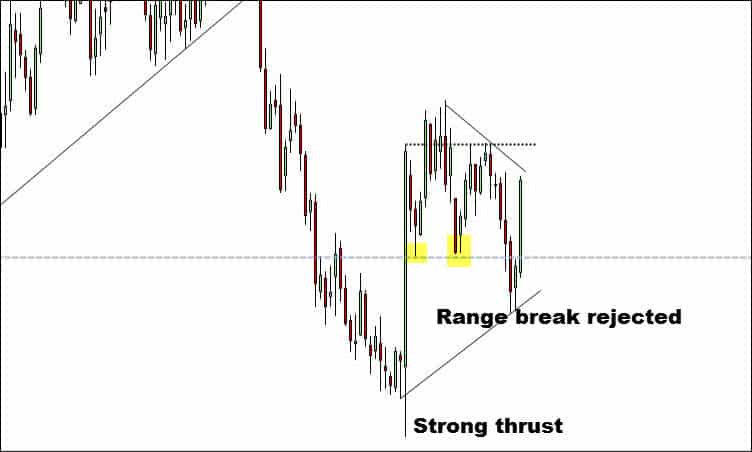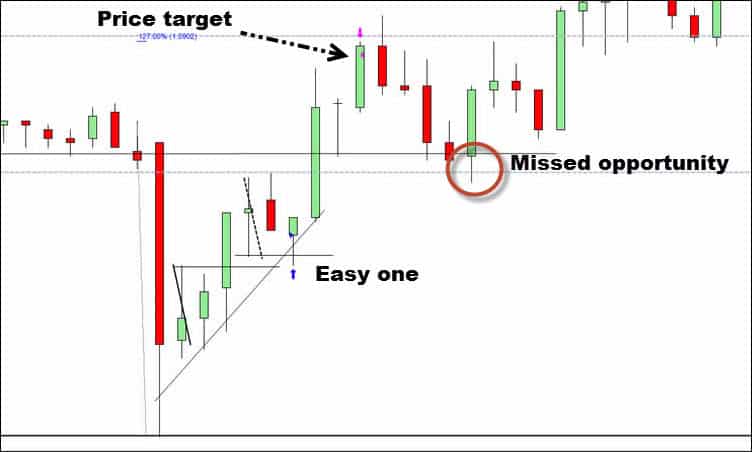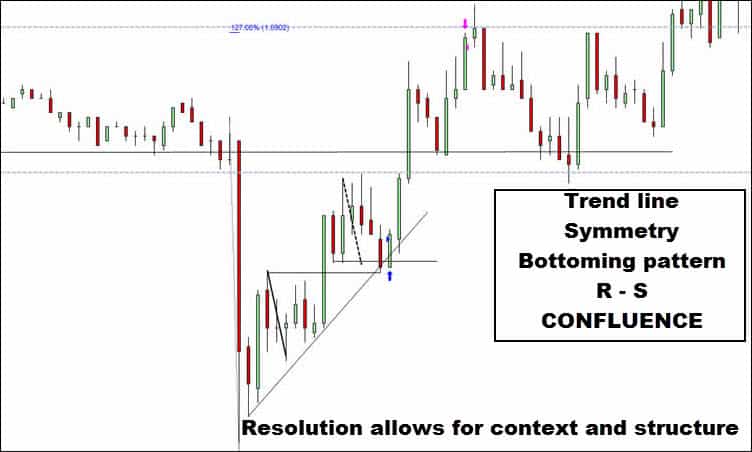- January 10, 2016
- Posted by: Shane Daly
- Categories: Advanced Trading Strategies, Day Trading, Trading Article

How much do you really know about price action trading?
Did you know that the daily price action in many instruments can offer up solid trading opportunities?
What do price action traders do differently?
Price action traders analyze price movements to decipher the probability of one thing happening over another with the minimal and sometimes zero use of any technical trading indicator.
Human behavior (algos notwithstanding) is what moves the market and it’s believed that this behavior repeats itself and is reflected in the movement of price.
You can profit from this behavior.
One way to think about it is that everything else is based on the action of price.
Price is where it all starts.
Knowing that, it makes sense to have at least a basic understanding of price action and the structures it creates.
Understanding that price action patterns exist, come to be due to human behavior and that this behavior encompasses emotional extremes, trading price action is a bona fide method of tackling the markets.
Let’s see price action trading with the Euro Futures Contract.
Related – Learn how Future contract rollover days work
Euro Futures Price Action Trading
It would take a long time to do justice to price action trading so the best way to cover some aspects of it is to talk through a Euro futures session.
One important thing to note is that the CME is changing the price increments of the 6E (euro futures symbol) as of Jan 10/16. The trading session being covered was the last trading day for full pip increments ($12.50) in the euro dollar. It will now be trading in 1/2 increments at $6.25/increment.
Trading day backdrop
Jan 8 was the day that the NFP (non-farm payrolls) was released at 8:30 New York Time. This is a release that can cause extreme volatility in the market but can also offer some potentially good trading after the initial shock has a chance to work off.
I admit that when I started trading years ago, I would attempt to trade the releases. It was hit and miss and I quickly realized that it was not something I was ever going to be good at.
Any time these events are scheduled, I do my best to avoid them.
This daily chart shows a strong thrust from lows which was a double bottom. This completion also hit a measured move objective after a demand line break from 10/15.

The range starts as a double bottom with lower highs and although price breaks support, it is being bought back up two days prior to the thrust. This just gives some context where we find ourselves when we go to the lower time frame.
This is a 5 minute Euro futures chart and shows the areas of interest during the trading session.
Because I was only looking for short term plays because of the added volatility of the NFP, I used a short time frame to seek out potential opportunities.

The price target is a combination of a measurement from the range break to the low of the momentum red candle to a tested resistance level off to the left. It falls below the high of the session at the time of trading.
What I saw after the NFP release
Obvious profit taking occurring after the news release and then sellers still tried to take the market back down. Once the march higher begins, some structure starts to form which then can form the basis for a trading opportunity.
There is no trade at the first push forward because at that time, there was nothing to base a trade on.
I am going to use the 2-minute chart for the rest of the coverage for better detail but in reality, the 5 minute was used until the price came close to areas of interest.

Resolution of the price action occurring after the release allows the opportunity to have a structure that will be needed if a trade opportunity presents itself. Dissecting price and the tale it can tell is vitally important to price action trading.
Related – How To Use Multiple Time Frames In Trading
Several Trading Strategies In One
There is not just one thing we are looking for when trading price action. A confluence of factors is important and can take into account S/R strategies as well as basic price patterns.
You will notice an upwards trend line and some of you may be asking why the low of the release was not used. It would be in a bigger picture analysis, however, there are only so many extremes. Inside of the extremes is where you find the gold.
Notice there were 4 hits on the line up to the trade entry.
Heavy hits matter to the relevance of not only trend lines but horizontal support/resistance lines as well. When one is used for both support and resistance, you want to take notice when price meets it again.
Keep in mind that multiple hits don’t equal strength but quite the opposite especially with horizontal lines.
When you find zones that are used for both support and resistance, that is a zone you want to to take notice of.
Also, think of how price moves on your chart. You see a strong thrust move and then a channel. Price breaks the channel making a strong move and then we head into a channel again. Looking inside the extremes of the channel, you will often see multiple hits at certain locations that will highlight where the important areas inside the channel are at.
If you just focus on the extreme supply and demand lines, there will be a lot of missed trading opportunity to pad your P/L.
Heading back to our chart….
Price thunders upwards and leaves us with a structure we can use. The solid small black line is measuring the pullback high to low and will be used once price begins another pullback and we will see if they are equal in distance (symmetry) We also have a high that rejected price that we can use for a possible retest.

A pullback begins and we overlay the line now marked with a dotted line and look to see if the pullback will terminate close in distance that occurred with the previous pullback.
We are able to draw a line where price is supported and then further to the right, we get a bottoming pattern (double bottom – basic chart pattern) that slightly penetrates to meet our former resistance level now showing support.
Our demand line extends right into the area of interest. A confluence of factors is important to virtually all price action strategies. Notice we are not only looking for a confluence of hits on any line we draw but also with any trading opportunity.
Once the resistance turned to support (R-S) is now holding at the confluence, it’s time to enter the trade. Taking too long to enter can have price leave the station without us and this trade was entered with about 30 seconds left on the clock.
Related – Use Confluence For Higher Probability Trading
Trade Management And Profit Taking
The trade starts off with the type of action we would love to see every time we enter a trade. I kept in mind that price did leave from a range and that it was possible we could get stuck in the range.
The range was most likely in place as traders waited for the NFP release and would not be much of a factor once the news was out.
The target was an extension from the range to the news low and projected upwards. It also fell in line with a notable resistance level from earlier in the session plus the high of the day (HOD) was just above.
Price does stall however it finds support at a level that provided multiple support hits early in the session prior to being shattered.
One final push to completion and after easily handing just over 40 pips, price tumbles to the range low.
After price hits target and tumbles lower, I missed the glaring trade setup here: Support level holding + Bottoming pattern + Failure test of lows = Confluence.
Can you spot it?
Trading Price Action Truths
- It is not as easy as simply spotting a pin bar. Price action and structure are not the holy grail that many marketers say they are. They fail just like anything else so while it is important to know what a successful play looks like, you also must know when the pattern has failed.
- Price action will not tell you what will happen next. Nothing in trading can with 100% certainty but the price will tell you what just happened. From there, your analysis and trade plan should tell you what action to take (or not take).
- Using a trading indicator does not discount price action trading. Many traders use a moving average for mean reversion or an extended market and then use price action and patterns to determine their next course of action.
- Support and resistance (potential) are also used in addition to price action as reaction points in the market. It is important that you define a consistent method for determining what will constitute a zone for your trading.
It can be simple.
What shapes price and structure are two-fold: momentum moves and reversion to the mean. The ebb and flow of price and as a trader, we look to find those times of imbalance and then take advantage of the opportunity.
Sounds simple enough but it is not something you will learn in a day. Yes, you can understand the patterns and even spot them, however, there is always a distance between understanding and execution.
Even if you use indicator based systems, learning even a simple price action strategy may have the effect of boosting the effectiveness of the system you are using.
The amount of focus you direct to any trading method that has proven itself in the market will have a direct relationship to the state of your profit and loss.
Your Next Step
Take some time going through your charts and see if you can lay down S/R zones using multiple hits as your guide to a quality level. Use the “look left” method where you start with recent price and move to the left.
Do the same with trend lines where you look for multiple touches inside of the extremes. To make it easier, look for strong runs in price and then seek out the channel for practice.
Once you have these plotted, watch how price reacts once it meets one of these areas or even better…when there is a confluence of variables coming together.
I will admit that this takes a lot of time to learn and implement. I am still working towards expanding my own repertoire of tradeable structures because you certainly want a toolbox you can draw from.
